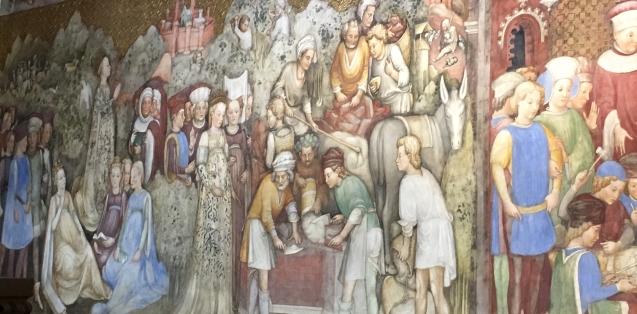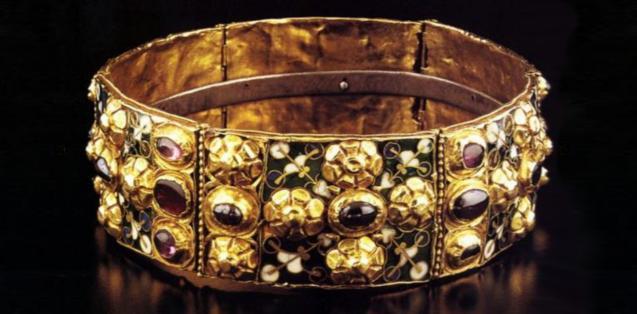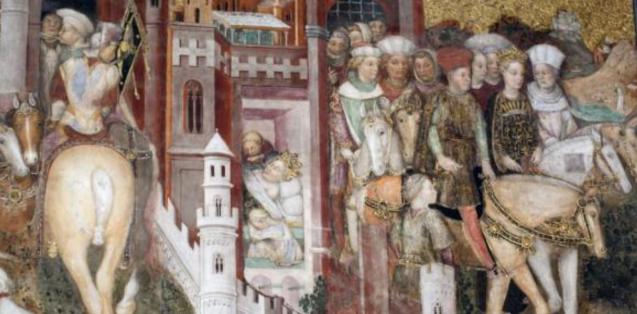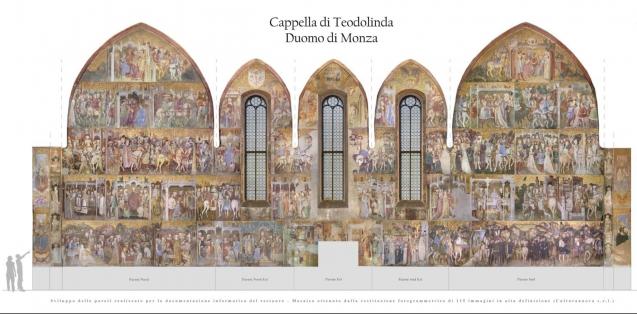Entrance from the Museo e Tesoro del Duomo, on the left of the bell tower
THE CHAPEL OF QUEEN THEODELINDA
The Chapel of Queen Theodelinda is located in the northern arm of the transept of the Cathedral of Monza. Of slender Gothic style, was built in the turn of the XV century. His pictorial decoration, dating from the mid-fifteenth century and dedicated to the Stories of Theodolinda, distributed in 45 scenes, looks like a heartfelt tribute to the Lombard queen who had founded the church. With the surviving works of Michelino da Besozzo, Pisanello and Bonifacio Bembo, which are closely linked in terms of style, the decoration of the chapel is considered one of the masterpieces of international Gothic in Italy, as well as the most important outcome of the art of the Zavattaris: a family of Milanese painters active in Lombardy through the fifteenth century, which is presented in the documents as a true dynasty of artists.
The 45 scenes depict the history of the Queen Teodolinda from the historical accounts of Paul Deacon (VIII sec.), Author of the History of the Lombards, and Bonincontro Morigia (XIV c.), Author of the Chronicon Modoetiense. Developed on an area of about 500 square meters and organized into five vetical registers, the narrative follows horizontally from left to right, and top to bottom, and is divided as follows: the scenes 1 through 23 describe the preliminaries and the wedding between Theodolinda, Princess of Bavaria, and Autari, king of the Lombards, ending with the death of the king; from the scene 24 to 30 are shown the preliminary and the marriage of the Queen and her second husband Agilulfo; from 31 to 41 are depicted the founding and early history of the Basilica di Monza, followed by the death of the King and Queen; from the scene 41 to 45 is finally shown the unfortunate attempt to reconquer Italy by the emperor of the East Holy Roman Empire, Constant, and his sad return in Byzantium. About 28 stages of the story are also dedicated to wedding scenes, related to the two weddings of the Queen. This circumstance leads to the belief that the paintings were conceived as a homage to Bianca Maria Visconti, according to the analogy that binds to the Lombard queen teh Duchess Lombard, who married in 1441 to Francesco Sforza, thus legitimizing his to succeedin Filippo Maria Visconti the dignity of duke of Milan. There are many scenes involving court life - dances, parties, banquets, hunts - but also travels and battles, and many details on fashion and costumes presented by the protagonists: clothes, hair, arms and armor, ornaments. All this provides one of the richest and most extraordinary sight on life at court in Milan in the fifteenth century, the environment perhaps more European in Italy those times.
The complex process used by the authors - in which coexist different materials and techniques as the fresco, tempera dry, the pad in relief, gilding and silver leaf - shows the extraordinary versatility of the Zavattaris art and responds perfectly to the climate that dominated in the courts and among the aristocracy of the time. On the altar of the Chapel, built in 1895-96 in neo-Gothic design by Luca Beltrami, is kept the Iron Crown, the most famous and sacred among the jewelery of the Treasury of the Cathedral of Monza.
THE IRON CROWN
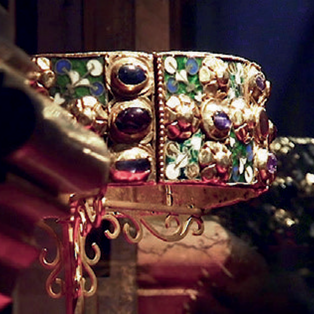 The Iron Crown has been preserved from the Middle Ages to the present day; it is composed of six plates of gold decorated with rosettes in relief, ouches of gems and enamels fixed on a circle of metal, from which it takes its name of "iron". An ancient tradition, already reported by sant 'Ambrogio at the end of the IV century, identifies this metal ring with one of the nails used in the crucifixion of Christ: a relic, then, that St. Helen would have found in 326 during a trip to Palestine and inserted in the diadem of her son, the Emperor Constantine. The tradition, which binds the Crown to the passion of Christ and the first Christian emperor, explains the symbolic value attributed by the kings of Italy (or the would-be, as the Visconti), which would use it in coronations certifying the origin from God of their power and their link with the Roman emperors. Recent scientific investigations do envisage that the Crown is derived from goldsmith carried out between the IV-V and IX centuries and it could have be a real sign in late antiquity, perhaps by the Ostrogoths, passed to the Lombard kings and finally to the Carolingian, who would have it restored and donated to the Cathedral of Monza. Since then the history of the tiara was inextricably linked to that of the cathedral and the city. In 1354, for example, Pope Innocent VI sanctioned as undisputed right of the Cathedral of Monza to host the coronation of the kings of Italy, and in 1576 St. Charles Borromeo instituted the worship of the Holy Nail, so is to make the official recognition of the tiara as a relic and to tie it to another Holy Nail, preserved in the cathedral of Milan, which the ancient tradition tells sant'Elena would have forge shaped a bite for the horse of Constantine, as further metaphor of divine inspiration in command of the Empire.
The Iron Crown has been preserved from the Middle Ages to the present day; it is composed of six plates of gold decorated with rosettes in relief, ouches of gems and enamels fixed on a circle of metal, from which it takes its name of "iron". An ancient tradition, already reported by sant 'Ambrogio at the end of the IV century, identifies this metal ring with one of the nails used in the crucifixion of Christ: a relic, then, that St. Helen would have found in 326 during a trip to Palestine and inserted in the diadem of her son, the Emperor Constantine. The tradition, which binds the Crown to the passion of Christ and the first Christian emperor, explains the symbolic value attributed by the kings of Italy (or the would-be, as the Visconti), which would use it in coronations certifying the origin from God of their power and their link with the Roman emperors. Recent scientific investigations do envisage that the Crown is derived from goldsmith carried out between the IV-V and IX centuries and it could have be a real sign in late antiquity, perhaps by the Ostrogoths, passed to the Lombard kings and finally to the Carolingian, who would have it restored and donated to the Cathedral of Monza. Since then the history of the tiara was inextricably linked to that of the cathedral and the city. In 1354, for example, Pope Innocent VI sanctioned as undisputed right of the Cathedral of Monza to host the coronation of the kings of Italy, and in 1576 St. Charles Borromeo instituted the worship of the Holy Nail, so is to make the official recognition of the tiara as a relic and to tie it to another Holy Nail, preserved in the cathedral of Milan, which the ancient tradition tells sant'Elena would have forge shaped a bite for the horse of Constantine, as further metaphor of divine inspiration in command of the Empire.


